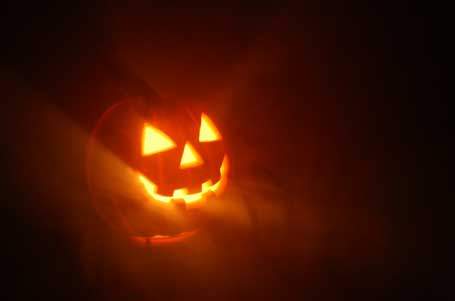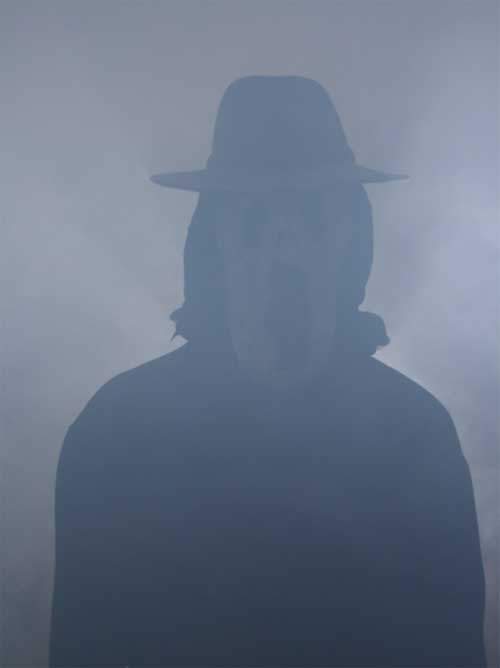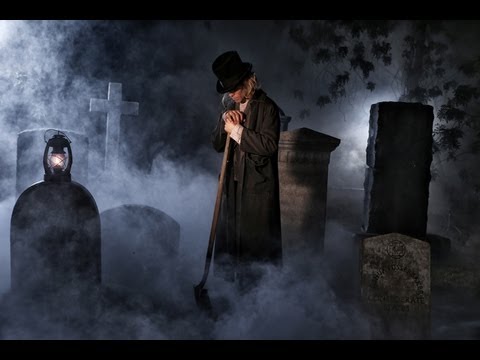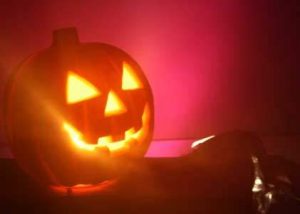Credit: Youtube, The Slanted Lens
Here’s some more in-depth prop info from guest contributor David Lay. Thanks again, David, for your spooky insights!
There’s doubt about it: Fog machines are cool. I usually don’t like expensive fancy-schmancy stuff to make my Halloweens creepy. But when fog machines came on the scene, and did so inexpensively, I had to get one! I waited until they were about $35.
The nice thing about a fog machine is it doesn’t take much to create a creepy, scary scene with one. In fact, a great fog machine allows cheapskates like me to fine-tune the art of “cheap.”
Always remember: what makes something scary is not what you see, it’s what you barely see, or see just in a flash, or maybe don’t see at all but you think it’s there.
Fog hides things so that you don’t see things clearly, or enhances light so that it gives objects a mysterious depth, like extending it out into the space around it, and hence makes it perfect for a good haunt.
Setting Up the Scene
But how to get the most out of the effect a fog can create?
I’ve been making up stories from when I was about 14 years old, and from that background I realized to make a Halloween spooky, you needed more that effects… you needed a story. The effects were there to enhance the story. Fog is simply a tool to make your Halloween story come to “life” (hmm, maybe a story about zombies).
Let me repeat myself: FOG IS A TOOL that is used to enhance a story.
It is not the story itself. And that’s where most folks make their mistakes when trying to out-do their neighbors. It’s like a movie with a lot of special effects, but if there is no story, you walk away from the movie feeling a little empty, like “What did I miss here?” kind of feeling.
The first step in using a tool is to learn how it can help you achieve your means. That means EXPERIMENTS! (Lightning flashes, thunder rolls, horses whinney – Igor, fetch me my lab coat!)
Fog and Light
Not all fog effects are scary. Sometimes they’re just plain cool, like at a concert where they shoot laser light through a fog to give a futuristic look. If you want scary, then experiment with your tools to get the effects you want. Try to keep in mind that everything happens for a reason: Light comes from somewhere and different light has a different emotional effect.
Fog is the same way. It takes you from a normal place and puts you where it’s mysterious, even scary. Think about where you’d find fog: In a hollow or on a dark night when the weather is changing. Fogs are common in the Fall. Use that to your advantage.
What if your “scene” took place in a “field” where the corn harvest was done, and stalks are stacked about? Fog belongs in such a place. But fog is just at home in, well, your home. Homes can have fog when there are ghosties around. Right?
Think about this: If you’re driving at night in a real fog, it’s tough because the light coming from your headlights is being reflected back at you. It makes a blank screen in front of you, and you can’t see beyond it. That in itself is not scary, but not being able to see beyond ten feet in front of your car and you’re going kind of fast can be scary. Anything could be moving around out beyond your lights. What if a deer jumps out? You’d not see it until too late… the effect is… drum roll please… startling… which is a form of scary.
Like I’ve said, sometimes it’s not what you see that is scary, it’s what you don’t see, or only see in a flash. Your imagination is put into “hi-gear” when it has to deal with imagined dangers.
Try a simple experiment with your fog machine: Get a small flashlight, and darken the room with your fog machine set up. Fog up the room and “play” with the flashlight. Cool, eh? The light is being bounced off the tiny smoke particles and you can see the light beam.
That little effect is powerful stuff because it’s just so cool. Now let someone else play with the light while you watch. Experiment with all kinds of lights and shadows. Here are a couple of photos from when I played with my flashlight in the fog:


There’s nothing really scary about the light, but you can see how light behaves. Every ray from the flashlight is seen, and the effect is, at the very least, mysterious.
Fog and Color
Color makes a difference, too. I know the neon-green-LED headlight advocates will disagree with me, and they have done so, too, but the best light to penetrate fog is yellow. Anyone want to guess why school buses are painted yellow? Because it’s mid-spectrum and your eyes see yellow far better than any other color. Have you ever driven down an isolated street in a fog when the golden hew sodium street lights are on? And have you ever seen blue safety reflectors on construction workers?
So what does this mean when you are building your Halloween scene? Based on what I said above, do I want a color that is not seen easily? Well, yes and no…
Look at these photos of a fake pumkin:
First image is with no fog, then with fog:
Here’s with no backlight and a little extra fog:

If I was using this pumpkin as a prop in my Halloween scene, I would have decided on just the light from the pumpkin. The orange light is much more powerful than the purple backlight, and the pumpkin looks like it is almost floating. I’ve seen this a thousand times over the years, and it still feels scary to me.
So, in this case, “yellow” light (well, orange, close enough) is best. I want the pumpkin to be seen, but nothing else.
Fog and Monster Props
You wouldn’t want to use natural light for monsters or live characters. The whole idea is for them to look fuzzy, mysterious, slightly unrecognizable…scary.
A live character might have a hard time emitting light from his eyes (well, alright, there was Mrs. Crombie in second grade…). So how to light that scene with fog?
Easy schmeezy: backlight.
Here are some photos of a simple “zombie” scene. I’ve used a simple shop light with some blue gel over it (see my previous article on lighting to learn about gels), and pointed it at the back of the “bad guy”. Again, I’m experimenting here. Note that all the character is doing is standing there:

And here’s the exact same scene with natural, yellowish-orange light. Not as dramatic and scary now!

This is a case where the blue light, which is not as easily seen, is better than plain light, which is closer to yellow, the kind of light your eye can see the best. The blue light didn’t let me see as many details, and therefore fell into the rule of “What you can barely see is scary”.
I learned a lot from my simple experiments above. So, let me give you the three rules of learning: EXPERIMENT, EXPERIMENT, EXPERIMENT. Then write down a simple story, and keep in mind you want to use fog to enhance the story (professional screenplay writers often will write a whole script around a very simple gimmick or concept, or perhaps they have a favorite actor and they write the play for them), and then create the story for real in your living room, back yard, or where ever.
Other Foggy Tips
Other things you can do with fog machines:
Controlling Where the Fog Goes
Get a long dryer vent and you can operate the machine in one room and put the fog in another. The vent allows you to put the fog up high, or down low… in other words, more control of your tool for telling a story, and you can hide the fog machine where no one can see it. This also allows you to have the fog come out of places where you wouldn’t expect it, like from inside a piano, or a coffin.
Misty Fog on the Ground
Another effect that is cool is not a fog, but a mist that hangs low to the ground. Here’s how: Get a large diameter tube, like a four or six inch dryer vent or PVC pipe, and a small diameter pipe, like a 2 inch PVC pipe, and put one inside the other. Have the tube and pipe at least four feet long. Six feet is better.
Cover one end with duct tape, but cut out a hole for the small diameter pipe. Put the tube on end and fill the area around the small pipe with ice. Then cover that end with duct tape, cut an opening for the smaller pipe, and put it up to the nozzle of the fog machine.
Viola, the fog cools as it travels down the pipe, and since it has less heat in it to rise, it holds close to the ground or floor! Warning, keep a towel under this little baby. Messy’s the word here.
Rosco makes a cooler for their fog machines that hook up to the nozzle and the fog runs into a pipe inside what looks like an ice chest, full of ice of course. Check out the Mister Kool Low-Lying Fog Machine. This machine is dedicated to making low laying mists and is self contained, and you don’t need to go out and buy a fog machine AND a cooler. Both companies sell a special fog juice formula
for cooled, low-laying fog.
When it comes to fog machines, the sky is the limit. Or, well, your haunt is the limit. The best tool you have for using fog machines is your brain. Go forth, then, and scare!







WOW!! i read the whole thing and i was trying to find something else but THANKs it was awsome and detailed
I love being scared and hope to pass that on to my kids. Like you mention, fog machines are great for making a haunted house. I always try to make my home as scary as possible, but love going to haunted houses as well to be frightened. All the decorations you mention make houses haunted, for sure.